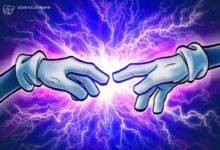China set to explore blockchain technology to facilitate electricity trading

The China Energy Administration (CEA) is set to investigate the use of blockchain-based power trading platforms to promote energy trade between self-contained power generation units and state and national networks.
Notably, the CEA, a state organization under the National Development and Reform Commission (NDRC), responsible for drafting energy policy, says the policy would look into the feasibility of small and medium-sized power generating and storage facilities serving local communities, according to a policy paper published on August 25.
The ECA stated:
“The Plan for Deepening the Reform of “Decentralization, Management and Services” and Optimizing the Division of Key Tasks in the Business Environment in 2022 has been deliberated and adopted by the Leading Group for Comprehensively Deepening Reform and Promoting Functional Transformation of the National Energy Administration.”
Blockchain tech used for power metering
According to the Institute of Electrical and Electronics Engineers (IEEE), the immutable property of blockchain technology may enable transparent and trustworthy power metering as well as evidence of transactions.
In July, a Chinese software company called Insigma Hengtian Software announced that it had been given a contract to deliver a blockchain-based power trading system by the Yunnan province.
The province of Yunnan has an abundance of hydropower resources and several small hydropower facilities all around the province. Before China’s crypto ban, Bitcoin miners gravitated into the province due to its abundant energy supply and favorable pricing structure.
Sichuan power shortage
It’s also worth mentioning that the latest heat wave and drought have already had a negative impact on China’s ability to produce and provide power.
In the last several weeks, the province of Sichuan has been experiencing significant power shortages, which have resulted in widespread power outages throughout both industrial and residential areas.
One of the primary reasons is that the drought has depleted local reservoirs, which in turn has cut hydropower, the region’s primary source of electrical generation, by more than half.






 Bitcoin
Bitcoin  Ethereum
Ethereum  Tether
Tether  USDC
USDC  TRON
TRON  Dogecoin
Dogecoin  Cardano
Cardano  Bitcoin Cash
Bitcoin Cash  Chainlink
Chainlink  Monero
Monero  LEO Token
LEO Token  Stellar
Stellar  Zcash
Zcash  Litecoin
Litecoin  Hedera
Hedera  Dai
Dai  Cronos
Cronos  OKB
OKB  Tether Gold
Tether Gold  Ethereum Classic
Ethereum Classic  KuCoin
KuCoin  Gate
Gate  Algorand
Algorand  Cosmos Hub
Cosmos Hub  VeChain
VeChain  TrueUSD
TrueUSD  Dash
Dash  Tezos
Tezos  Stacks
Stacks  IOTA
IOTA  Basic Attention
Basic Attention  Theta Network
Theta Network  Decred
Decred  NEO
NEO  Synthetix
Synthetix  Qtum
Qtum  Ravencoin
Ravencoin  0x Protocol
0x Protocol  DigiByte
DigiByte  Nano
Nano  Zilliqa
Zilliqa  Siacoin
Siacoin  Numeraire
Numeraire  Waves
Waves  BUSD
BUSD  Status
Status  Enjin Coin
Enjin Coin  Pax Dollar
Pax Dollar  Ontology
Ontology  Hive
Hive  Lisk
Lisk  Steem
Steem  Huobi
Huobi  NEM
NEM  OMG Network
OMG Network  Bitcoin Gold
Bitcoin Gold  Augur
Augur  HUSD
HUSD  Ren
Ren